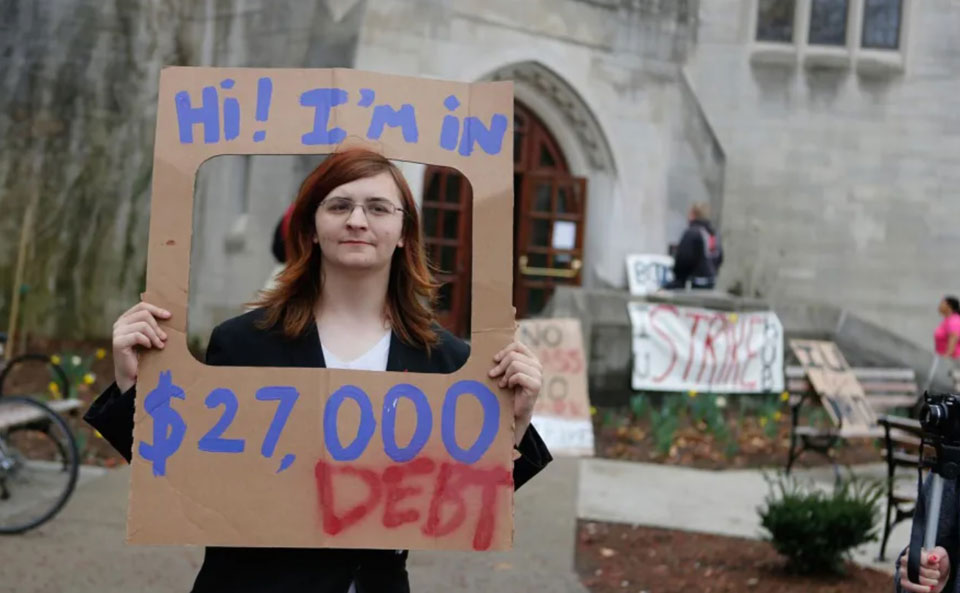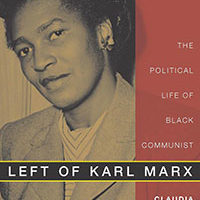
WASHINGTON– When people involved in the fight to cancel student debt demand free college education they are not calling for a new, radical idea. Countless numbers of lawmakers, for example, got their educations at free colleges that they now say are out of reach to the nation’s students.
One of the best examples was the City University of New York whose many four year colleges and community colleges were tuition free until the late 1960’s. They even had an open admissions policy resulting in not just the admission of minority students but the opening of their doors to countless white working-class students.
And, of course, countries in Europe and elsewhere offer free college education to this day, enabling working-class students to gain an education that allows them entrance into professions out of reach to U.S. students today.
Answers to how this all ended and how millions in America carry the burden now of crushing student debt were forthcoming recently here at a panel discussion sponsored by The Claudia Jones School for Political Education. The school, on the evening of August 19 last month, hosted organizers from the Debt Collective and the D.C. Poor People’s Campaign on the evening of August 19 to help explain what it is that has killed free college education in America.
The Debt Collective is actually a membership organization working to transform our individual financial struggles into a source of collective power. Debt Collective offers services to empower people and dispute debts and is conducting direct actions and campaigns of non-cooperation with the finance industry. They work toward broad debt cancellation while fighting for policies to end mass indebtedness including free public higher education, universal healthcare, worker-owned business, fair wages for everyone, decarceration and reparations for racial justice. The panelists who represented the Debt Collective were Dr. Hannah Appel, a co-founder and Jacques Laroche, the technical projects manager.
The program begin with a presentation on the underlying reasons for tuition costs and student debt. College and public universities were tuition free up until the mid-1960s. White students were favored until an explosion of protests across the country, led by groups that included the Brown Berets and the Black Panther Party, forced the introduction of things like Black and Chicanx studies and departments.
In California, Ronald Reagan (who would later become president of the United States) was elected governor of California in 1966 and proposed that the University of California system should charge tuition to attend college. In his words, this was to “get rid of undesirables […] those who are there to carry signs and not to study might think twice to carry picket signs.” His was a campaign to maintain white supremacy by making public colleges and universities cost money. Reagan succeeds and by the 1990s, every “formerly public” school began being paid for by tuition costs, which in turn turned into student debt. This was a slap in the face to those who were protesting white supremacy, capitalism and imperialism because it put these folks in debt.
As a result, the student debt crisis ensued. Student debt quadrupled between 2004 and 2019 to now a whopping $1.6 trillion dollars! The average student debt from people graduating in 2018 was $30,000 with an onset of one million new defaults on student loans each year. To sum it up, from 1964 to 2019 tuition costs soared by 3,819% thanks to Ronald Reagan.
“This mass indebtedness has profoundly deepened the pre-existing racial and gendered inequalities in the United States,” says Appel. This is a result of the systemic disparities from predatory inclusion and racial capitalism. Predatory inclusion is where the financial actors offer needed services to Black and brown households but on exploitative terms that limit or eliminate their long-term benefit.
People that get college degrees and want to do something positive for their community without getting sucked into the for-profit, monopoly capitalist system, typically have no choice but to get a job at a for-profit firm to pay off their debt.
Student debt takes effect along racial and gendered lines with a borrowing comparison of 63% to 81% from white to Black graduates. Four years after graduating, Black graduates have average loan balances more than twice of their white counterparts. More than half of Black households under 40 have student debt and more than half of Black borrowers and 44% of Latinx borrowers are either in default or delinquent on their loans. Further, there is discrimination in the labor market due to gender and racial wage gaps and differential access to intergenerational wealth (White people more typically have a wealthy family member that can help them with their debt).
It was repeated throughout the evening that student debt is a “systemic condition, not the individual failure of those who make poor choices in a fair system” and is a result of racial capitalism. Appel also mentioned that financial illiteracy is seemingly used to pinpoint the poor choices Black, brown, and indigenous people make and reiterated that this is not an individual failure of those who make poor choices. but systemic conditions requiring collective responses.
The topic of debtor’s unions was discussed.
The first debtor’s union was launched in 2014 to go after for-profit colleges. The “Corinthian 15” were the first to go public with their student debt strike and two years later many of the strikers got their debts erased and refunded (approximately $1.5 billion dollars in debt abolition).
Appel said that the Debt Collective does not use the word “debt forgiveness” because they don’t believe that debtor’s need to apologize for what they’ve done. They prefer to use the terms “debt abolition” or “debt cancellation.”
An important step forward was Minnesota Democratic Rep. Ilhan Omar’s Student Debt Cancellation Act of 2019, where Omar and other members of Congress are proposing to eliminate all outstanding debt, eliminate tuition and fees at all public schools and universities, and provides funding streams to HBCUs and Tribal colleges, makeing funding contingent on university working conditions. Three quarters of instruction must be provided by tenured or tenure-track faculty, and there must be a drastic reduction in subcontracted non-union labor. Further, left and progressive organizations such as the Red Nation and the Movement for Black Lives have incorporated debt cancellation into their national platforms.
Laroche was able to bring the conversation on debt into an internationalist perspective with his own story as a son of Haitian immigrants. He said that he dropped out of grad school $30,000 in debt and will never pay it off. “I’m not paying for the humiliation […] something that was forced onto me.”
Laroche continued by saying that he is a product of imperialism and colonialism. For the former, the U.S. invaded Haiti in 1915 and occupied the country for 15 years after overthrowing a U.S.-friendly coup leader. For the latter, Haiti was a French colony prior to the revolution and in 1825 the French came back to Haiti with a contingent of battleships and asked for reparations, in which $21 billion dollars were eventually given–placing the country into a struggling economic situation.
“Debt turns citizens into indentured servants and international systems of debt and it turns sovereign nations into enslaved entities,” Laroche said.
These developing countries cannot pay for their own infrastructure, healthcare, and education systems. “So when we hear about a debt crisis in Greece or a failing economy in Jamaica, this is just another version of our aunt who got a predatory home loan and lost her house in the 2008 crash.”
The program ended with Zillah Wesley II, one of the co-chairs of the D.C. Poor Peoples Campaign, A National Call for Moral Revival, speaking on the organization’s history and strategy around organizing people to fight debt. The campaign goals are to shift the narrative, build power and impact elections and policies. The Poor Peoples Campaign has been exposing the inequalities in the U.S. by repeatedly saying that there are 140 million poor or low-income people in this country (including 52.2% children, 41.9% elders, 60.4% Black, etc.), 60 million people working for less than $15/hr., 87 million people who are uninsured and underinsured, 23 million families with a net worth of zero dollars or less, 14 million families who cannot afford water, and 10 million who are homeless or are on the brink of homelessness. Wesley went on to repeat what was said earlier by saying that education is underfunded and unequal.
Among single college students with children, 88% are poor or low-income. Student debt affects 43 million Americans. The total average cost of a four-year college in 2015 was $25,409, which is 2.5 times as much as in 1968 (adjusted for inflation). Wesley ended by noting that corporations are making super-profits off of this crisis and the ongoing pandemic and linked the looming housing issue with the debt crisis.










